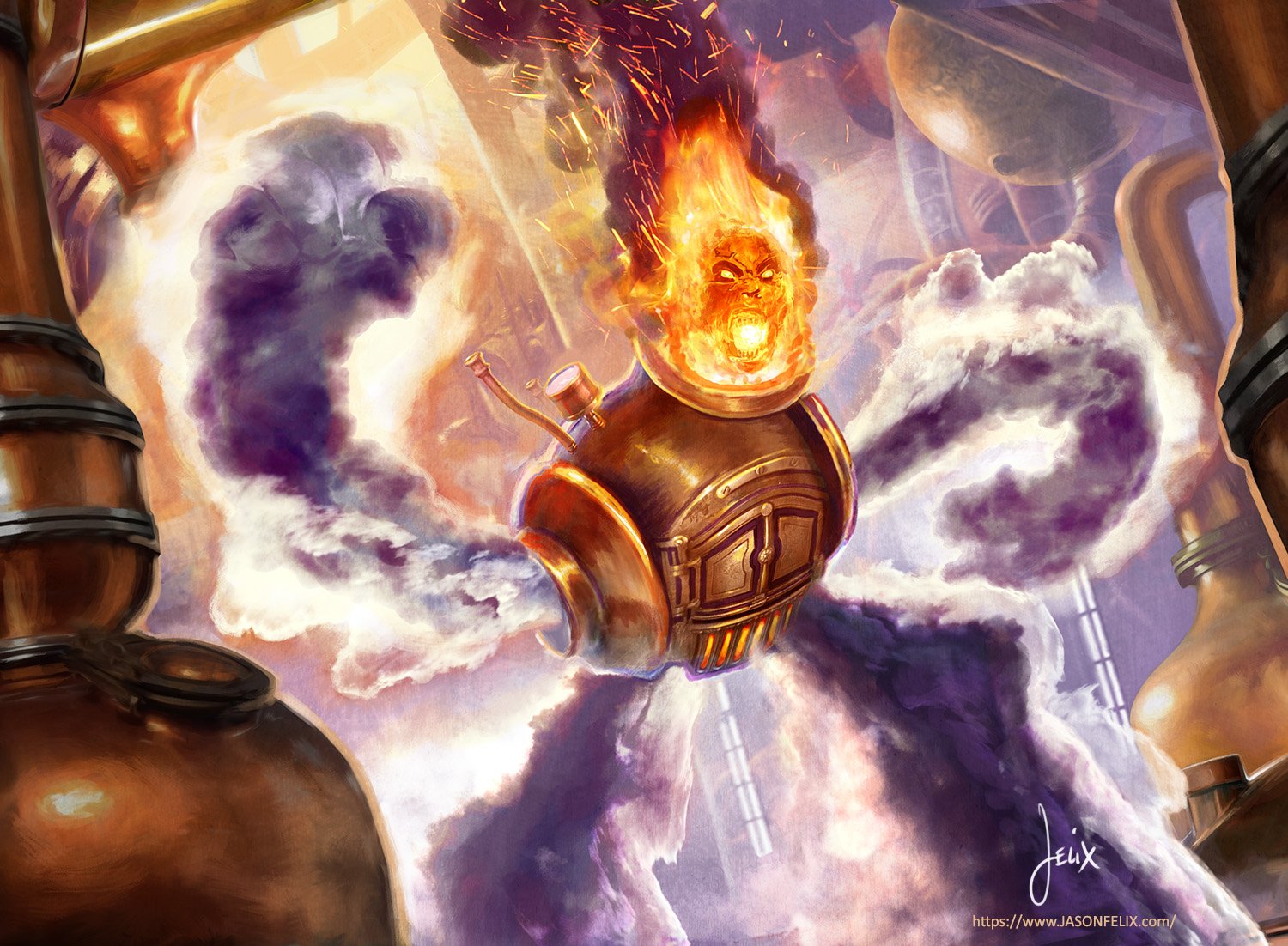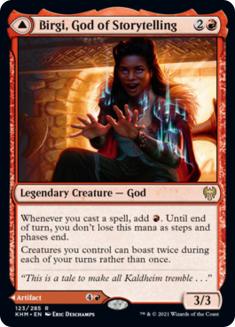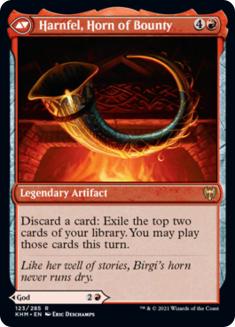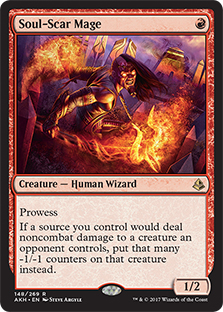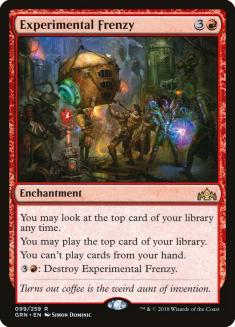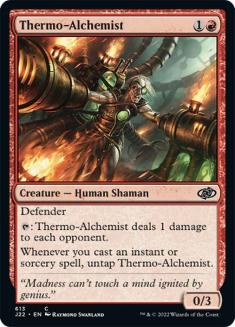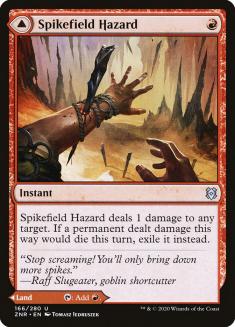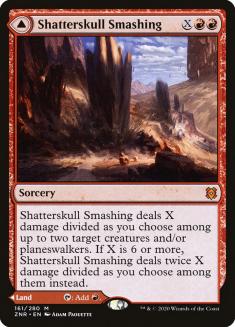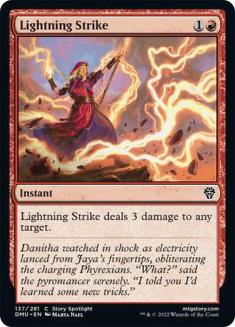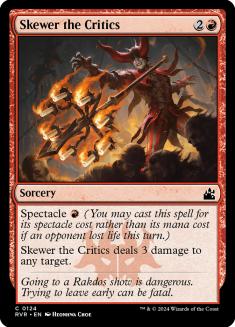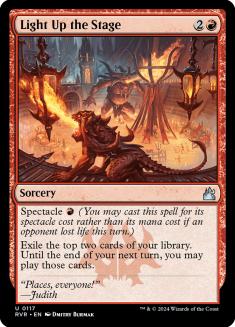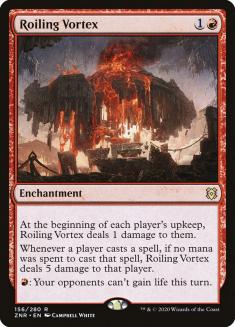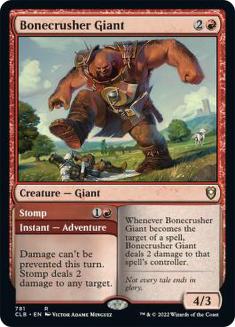Earlier this week, I wrote an article focusing on Mono-Red Aggro in Standard, exploring a few different ways you can approach the archetype in the deckbuilding phase. Even though Embercleave is currently the most powerful red card in the format, that doesn’t mean other powerful red cards can’t justify alternative builds! The same is true for Historic, but we get a lot of tools that can actually compliment these new engines from Kaldheim.
As I mentioned earlier in the week, the only card that’s been on my mind lately is Birgi, God of Storytelling.
The front half is effectively a slightly more expensive version of Runaway Steam-Kin. The back half is a lot like Experimental Frenzy. Having both rolled into one card means we get a bit of redundancy, but also that drawing more than one copy of this legendary creature isn’t a bad thing. Both halves work together, with one side building your mana and the other building your raw resources. When you get eight virtual copies of Runaway Steam-Kin and Experimental Frenzy, and can cast whichever is best in the current situation, you gain a lot of control on how the games play out.
When starting this project, my first instinct was to go low to the ground. The best draws featuring Experimental Frenzy usually involved cheap burn spells because they allowed you to turn that raw card advantage into an actual game advantage. If all you do from the top of your library is cast a few more creatures, you might be disappointed at the end-game. We’re trying to bring something a bit more tangible to the equation, turning those extra resources into a lot of direct damage.
With Birgi on the brain, here’s where I’m going to start in Historic:
Creatures (16)
Spells (44)
- 18 Mountain
- 4 Shock
- 4 Lightning Strike
- 4 Experimental Frenzy
- 4 Light Up the Stage
- 4 Skewer the Critics
- 2 Spikefield Hazard
- 4 Shatterskull Smashing
Sideboard

First and foremost, this deck should thrive in a creature-heavy format. All your cheap removal should cause some major headaches for anyone attempting to cast Llanowar Elves or other cheap creatures. Even though it might take two spells to take down a larger monster like Lovestruck Beast, your multiple card advantage engines should help alleviate some of that pressure on your raw resource count. Soul-Scar Mage is also another great tool to help contain stocky minions.
An important part of the curve, Soul-Scar Mage provides you with the most efficient body for one mana that you could want in an archetype like this. The cheap prowess creatures are often some of the most powerful in other formats, and Historic is no exception. With so much degenerate junk happening all over the place, having a start that features a lot of damage output when your opponent isn’t interacting is huge.
Testing of this list might help us deduce the optimal build. More one-drop creatures like Ghitu Lavarunner could be helpful, if only for increasing the Wizard count to support Wizard’s Lightning. Right now, my goal is to figure out how many engine pieces we want, as well as how to surround those engines. Currently, we’re sitting at eight virtual copies of both halves, the mana and card engines. Assembling one of each should be more than enough to win any fair game. Some draws will feature multiple mana engines or multiple draw engines, but luckily Birgi’s dual-sided nature means you won’t draw too many of the wrong half.
The less interactive the format becomes, the worse our deck is. Cards like Experimental Frenzy and Harnfel, Horn of Bounty gain stock when the opponent is hitting you with discard, removal, or other forms of interaction. If you’re able to stick either of these cards, you should be able to overcome any opponent trying to trade one-for-one. As the game progresses, you’ll have to beat their finisher, but that shouldn’t be too hard. Putting them to zero life negates any amount of card advantage they might have gained.
The cool part about this deck is that, at times, it feels like you’re assembling a combo that outright ends the game. At other times, it feels like an aggro strategy that puts the opponent on a significant clock. Uro, Titan of Nature’s Wrath will be a nightmare to play against, as always, but an engine like Experimental Frenzy or Harnfel, Horn of Bounty can help you fight back. Winning longer games by dealing them a ton of direct damage usually costs too many resources to sustain. I’m hoping that our two engines will help push our burn package over the top once assembled.
My experience playing Runaway Red in Standard against all forms of Wildgrowth Walker hellbent on gaining a ton of life helped me realize that winning the game via direct damage was not feasible without some sort of multiplicative damage output. Raw card advantage via Experimental Frenzy helps push you over the top when things get close, and the occasional pairing with Runaway Steam-Kin let you do some chains that are just bonkers. We were somewhat limited in what we could do with the “combo” in Standard, but Historic offers quite a few more weapons than we initially had access to.
Thermo-Alchemist was a favorite of mine during its tenure in Standard. I think the term “untap” is my catnip. All my Magic sensibilities go out the window! All I want to do is push and push until I break or fail when a card like Thermo-Alchemist comes along. Untapping with it the first time usually means it’s dealing two or three damage on the rip, but it often leads to significant damage output when you have Runaway Steam-Kin or Birgi, God of Storytelling on the battlefield.
Thermo-Alchemist doesn’t hit creatures, but that’s okay! Think of it like a “damage engine,” similar to how Runaway Steam-Kin is a mana engine or Experimental Frenzy is a card advantage engine. It’s very cheap, gets around having to attack to deal damage, helps pressure planeswalkers in weird spots, and does some truly absurd things when all your other cards are online. On regular damage rate, it ranks about as high as, if not higher than, something like Watchwolf. I can’t imagine you’ll deal less than two damage per turn with Thermo-Alchemist on your side.
If we end up moving to a Wizard base, Viashino Pyromancer will likely fill this slot. Wizard’s Lightning is absurd, but if Thermo-Alchemist ends up being as good in this shell as I think, we might not need Wizard’s Lightning at all.
These two cards are excellent in this style of deck because they act as mana sources that don’t screw up your Experimental Frenzy turns! With cards like Experimental Frenzy and Harnfel, Horn of Bounty in your deck, playing a few more lands than normal is solid, and especially so when those lands function as perfectly reasonable and relatively cheap spells. Shatterskull Smashing might not be all that efficient most of the time, but entering the battlefield untapped as a land essentially means it’s free.
Spikefield Hazard costing one mana makes Birgi and Runaway Steam-Kin better while doubling as a land to help you curve out with your engine cards. My heart is telling me to play four copies because it’s just perfect, but my head says the extra damage from Shock might be the difference in winning and losing the game. Having a few supplement Shock seems reasonable, though testing is necessary to see how many I actually want in the deck. At the moment, all of this is theorycrafting. Until I play more games with Birgi, knowing the exact right numbers on each card will be virtually impossible.
This is our core burn package, acting as our way to close the game when we get our engine running. Alongside Experimental Frenzy, the damage output of these types of spells compared to their casting cost is ridiculous. Skewer the Critics specifically gives you one of the most efficient burn spells in a deck that desperately wants Lightning Bolt.
In some scenarios, a combination of burn alongside Thermo-Alchemist or just Soul-Scar Mage might be enough to steal games without heading to the late-game. Your engine cards are great, but the upside of playing an aggro deck is that you get to win games for free. Since your deck is full of cheap spells, both players stumbling can result in you getting a threat or two onto the battlefield while your opponent struggles to keep up.
Old-school burn spells always have the upside of going to the dome when they can’t kill an opposing creature or you’re just trying to finish the game. The variable nature of burn spells is one of the things about red removal that sets it apart from the other colors. A recent push toward dealing damage to a “creature or planeswalker” instead of player means the classics are starting to fade, but Historic still has all the goods.
Light Up the Stage is close-ish to the other engine cards but it’s significantly cheaper and helps elongate card/damage chains once you get your engines online. Light Up the Stage is usually better in a pure aggro deck because it offers the aggro deck something it doesn’t normally get: card advantage. Our version has a bit more card advantage than normal, but Light Up the Stage is still cheap as hell and relatively easy to turn on once you get situated.
Light Up the Stage is one of my favorite cards in the Modern version of Mono-Red Prowess, giving you more raw burn spells and land drops for an exceptionally low cost. While we won’t be casting it on the second turn too often, outside of desperation or attacking with a Soul-Scar Mage, it can make all the difference in your weaker draws. It seems quite strong with Thermo-Alchemist, providing multiple-spell potential while being ping-enabled. Whenever you find mad synergy between two different styles of card, and both fit into your deck easily, why would you not do everything in your power to foster that synergy?
The Sideboard
Roiling Vortex actually rules in this archetype because you have enough raw resources to burn your opponent out through a boatload of removal and/or lifegain effects. What you can’t beat is an Uro that’s attacking over and over again. And for that, Roiling Vortex is the answer.
The enchantment bit makes it hard to interact with, meaning they’ll need Assassin’s Trophy or something similar to handle it, but those types of cards are rare compared to Eliminate and other creature removal. Plus, having more weirdo permanents for them to deal with makes your other engines more likely to stick around! Even if they do use Assassin’s Trophy or some other thing to kill your Roiling Vortex, they used two mana to your two mana and probably won’t have a way to kill Experimental Frenzy if it comes down at a reasonable pace.
This one probably deserves some maindeck consideration. In a perfect world, we’d be playing Bonecrusher Giant in every red deck ever made, but desperate times call for desperate measures. Choosing Thermo-Alchemist over Bonecrusher Giant is a choice and one I make gladly. In the future, if the opponents move toward a lot more small creatures, Bonecrusher Giant will obviously be a home run. In matchups where Shock is bad, Bonecrusher Giant can come in and give you a bit more threat density.
I see Bonecrusher Giant as a tool that red always has access to, regardless of whether or not it’s actually good. It solves problems that you can have on multiple fronts. Given enough time, a single Bonecrusher Giant can amount to quite a few cards from the opponent. It also fits the curve perfectly, acting as interaction into threat for the second and third turn.
We can’t really play Grafdigger’s Cage because it negatively affects our Experimental Frenzy. Easy swap.
In some scenarios, we might need some help dealing with all-in creature rushes. Goblin Chainwhirler is pretty good at that, but also solid in a few other matchups. The ability is distinctive, and attaching it to a decent-sized body is a huge plus. Being a creature also means we can just bring it in against matchups where we want more raw threats. Sometimes having cards that are just “good” in your sideboard is perfect because they can replace mediocre/dead cards.
Another no-brainer, Abrade is just a solid removal spell that answers a few of the format’s more interesting cards. God-Pharaoh’s Gift comes to mind here, but there are artifacts running around all over the place. We don’t need to kill Grafdigger’s Cage specifically, but it’s nice to know that Abrade is in our list and can come in when necessary.
On That Note
Here are some quick notes to keep in mind while trying this deck out.
- Birgi, God of Storytelling plus Runaway Steam-Kin generates extra mana.
If you have two of your mana batteries on the battlefield, every one-mana spell you cast can generate a mana. We’ve seen this with multiple Runaway Steam-Kins before, but it’s more plausible now that we have more virtual copies. If your engine is running, look to pair these up so you can go longer.
- Shatterskull Smashing is mediocre, but free.
There will be times where Shatterskull Smashing actually saves your butt. This is one of your only spells that scales nicely as the game progresses. Drawing one when you’ve hit your first six land drops is great. It’s certainly better than Mountain! The three damage it deals to you to play it untapped is minuscule.
- Skewer the Critics sucks, but it’s powerful.
I sideboard out Skewer the Critics in more situations than I’m proud to admit, but is perfect when you need it to be. This is your Lava Spike. Wear it proudly like a badge of honor.
- Wizard’s Lightning might be nuts.
I’ll be looking at different builds this weekend featuring Wizard’s Lightning. It’s obviously a great card, and will be easy to implement if Thermo-Alchemist doesn’t work out.
- Hold onto Light Up the Stage.
There won’t always be a perfect time to cast Light Up the Stage, but you should definitely treat it a little more like Brainstorm. If your opponent has no creatures on the battlefield, casting Light Up the Stage means you’re likely to hit a dead-ish burn spell. The longer you hold onto Light Up the Stage, the better it becomes. When you have more mana, you’re virtually guaranteed to be able to use both cards. Early in the game, you can burn it to hit land drops, but don’t just slam it when you have perfectly reasonable plays to make.
- If you start tweaking the list, find ways to lower the curve.
When it comes to deckbuilding, finding the right build is often a game of inches. That’s especially true in an aggro deck, since stumbling early on means you won’t be getting full retail on your handful of tiny monsters. The longer it takes you to empty your hand, the worse things are gonna be by the time your opponent hits their stride.
When I was building this list initially, I showed it to a few friends. Their common line of thinking was that it was a bit too clunky. I think the variable nature on many of your spells allows you to sequence your draws however you want. Adding more variable cards to the list, like Bonecrusher Giant, can probably alleviate some of those concerns.
Well folks, that’s all I got for ya this week. I hope you’ve enjoyed my rantings on red in both Standard and Historic this week. I loved Runaway Red when it was in Standard, and I’ve tried multiple times to make it work in Historic and Pioneer to no avail. I’m thinking Birgi, God of Storytelling might be a good enough mana engine to make Experimental Frenzy disgusting. It’s at least the most interesting red card in the set, so I might as well build some decks around it!
Next week I’ll have played with these new cards a bit. I have some ideas on how to implement some of these new goodies into Pioneer, so I’ll likely be focusing on that as my next project. If you have any brews around Birgi, hit me with them on Twitter! I’d like to see them.

